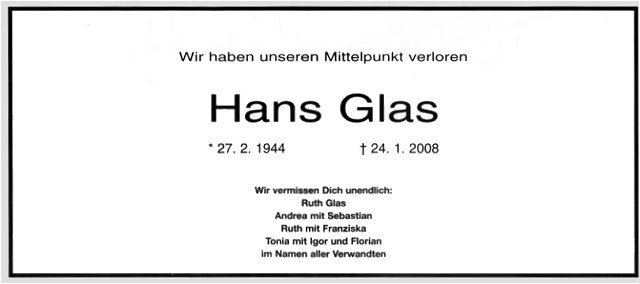Founded 1883 | Ceased operations 1966 | |
 | ||
Glas bmw 3000 v8 test drive in top gear rare bmw glas frua body scc tv
Hans Glas GmbH is a former German automotive company, which was based in Dingolfing. Originally a maker of farm machinery, Glas evolved first into a producer of motor scooters, then automobiles. It was purchased by BMW in 1966, mainly to gain access to Glas's patents; they were the first to use a timing belt with an overhead camshaft in an automotive application. Its limited model range was shortly phased out by its new parent.
Contents
- Glas bmw 3000 v8 test drive in top gear rare bmw glas frua body scc tv
- Bmw with strong glass
- History
- Products
- Scooters
- Cars
- Absorption by BMW
- Changes under BMW
- Closure
- References
Bmw with strong glass
History
Mechanic Andreas Glas founded a repair company for agricultural machines at 1895 in Pilsting. He named the company Andreas Glas, Reparaturwerkstätte für landwirtschaftliche Maschinen mit Dampfbetrieb (in English: Andreas Glas, repair-shop for steam-powered agricultural machines). During the summer periods about 16 people worked for him. In 1905 Andreas Glas' company built their first sewing machines. He then had sufficient work to employ all his employees during the winters. The production of sewing machines rose from year to year:
Winter period 1905/06 - 10 sewing machines Autumn 1906 - 20 pieces Winter period 1906/07 - 40 machines 1907 - 60 pieces Winter period 1907/08 - 254 sewing machines.Since 1905 Glas had a branch office in Dingolfing. He started to produce in Dingolfing in 1908 with 150 sewing machines per year. The production count rose each year.
After World War II, the market for sewing machines was declining, and the company began building little carrows and later working machines for bakers along with sewing machines.
Products
Glas were known for small cars like the Goggomobil. However, in 1964 the company introduced the Glas 1300GT coupe and later the 1700GT. The body was designed by Pietro Frua. However competition, mostly from British cars, was tough and in 1966 they released the 2600GT powered by a SOHC V8 engine, with a volume just under 2.6 litres. However this didn't help and later the same year the company was sold to BMW. The Glas models were kept in production by BMW, but fitted with BMW engines. The Glas 1300 GT coupe was fitted with a 1.6-litre BMW engine and renamed BMW 1600 GT. BMW also fitted a 3-litre engine and named it 3000 GT. This model kept the Glas name, but had a BMW logo in the front and rear. In 1968 BMW created their own large coupe, the BMW 2500 CS, and this meant the end for Glas. 277 copies of 2600 GT was made and 389 of the 3000 GT.
Scooters
In 1951 Andreas Glas saw the Vespa scooter from Piaggio in Verona, Italy. He was so enthused that he began production of motorscooters that July.
The scooter debuted with a 125 cc motor, increased over time to 150 cc and 200 cc. Until 1956 46,181 motor scooters were built. Production of scooters stopped because of the Goggomobil cars. From 1953 on, load-carrying scooters were built as well. With the 200 cc engine and 9.5 bhp, they had a load capacity of 200 kg.
Cars
Absorption by BMW
In 1962 BMW released the BMW 1500. The popular four-door compact's success exhausted the production capacity of the Munich plant. In 1966 management decided to buy Glas and absorb the Glas model line. Most of Glas' existing lineup was retired, while some models ended up being badged as BMWs until the company was fully absorbed. It was reputed that the acquisition was mainly to gain access to Glas' development of the timing belt with an overhead camshaft in automotive applications, although some saw Glas' Dingolfing plant as another incentive. However, this factory was outmoded and BMW's biggest immediate gain was, according to themselves, a stock of highly qualified engineers and other personnel. The Glas factory began the manufacture of BMW front and rear axles until they could be modernized and fully incorporated into BMW.
BMW immediately retired most of the Glas range, including all of the outdated microcars.
Changes under BMW
Closure
In the late 60s BMW shut down Glas and built entirely new production facilities which would eventually become an important production site. As of 2008, BMW's Dingolfing branch is BMW's largest factory, with 22,000 workers producing both thirteen hundred 5-, 6- and 7-series cars and bodies for Rolls-Royce.
